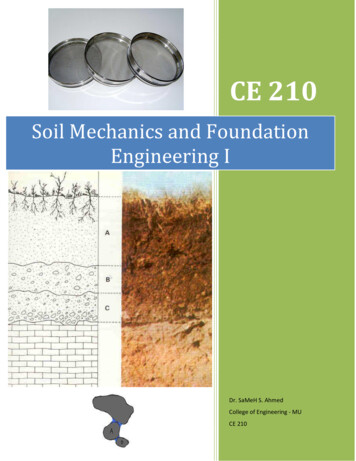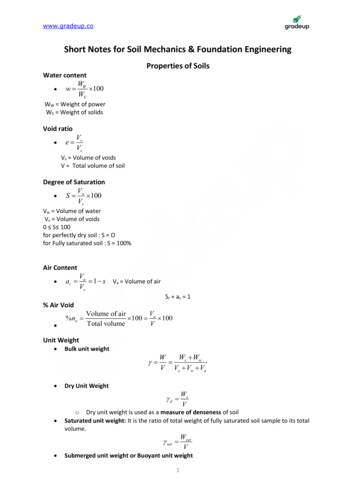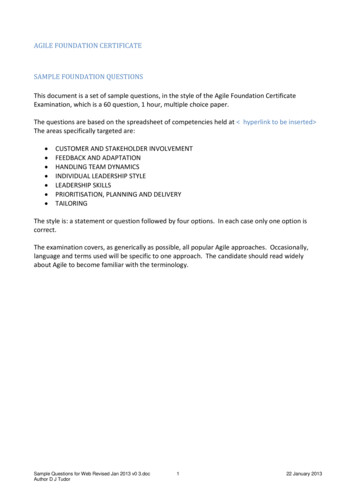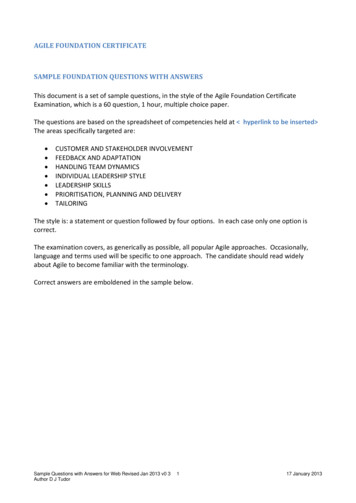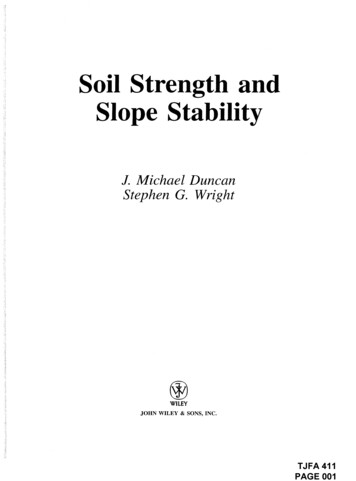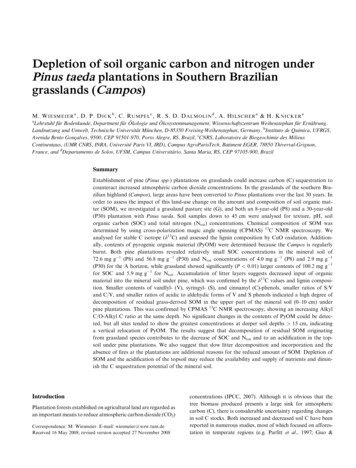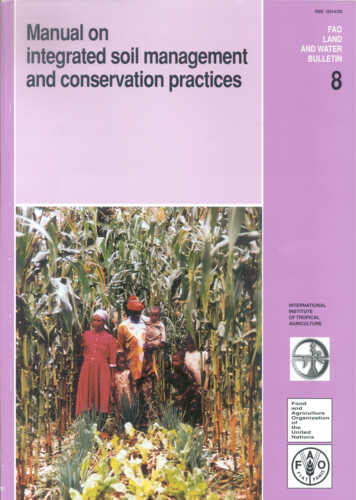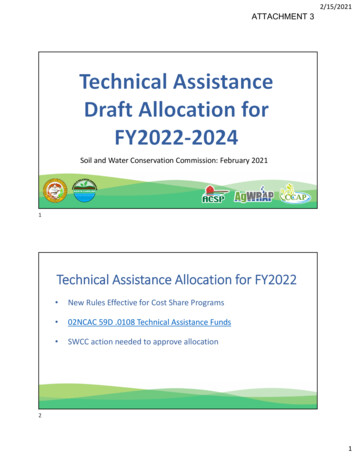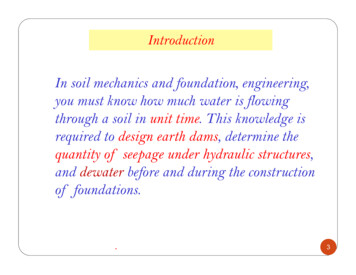
Transcription
IntroductionIn soil mechanics and foundation, engineering,you must know how much water is flowingthrough a soil in unit time. This knowledge isrequired to design earth dams, determine thequantity of seepage under hydraulic structures,and dewater before and during the constructionof foundations.Dr. Abdulmannan OrabiIUST3
Soil PermeabilityPermeability is defined as a capacity of soil toallow water passes through it i.e. quantity offlowing for a unit of soil surface under a pressureof 1 unit hydraulic gradient.Dr. Abdulmannan OrabiIUST4
Soil PermeabilitySoils are permeable due to the existence ofinterconnected voids through which water flowfrom points of high energy to points of lowenergy.Dr. Abdulmannan OrabiIUST5
Soil Permeability A soil is highly pervious when water can flowthrough it easily. (Gravels) In an impervious soil, the permeability is very lowand water cannot easily flow through it. (Clays) Rocks are impermeable The study of the flow of water through permeablesoil media is important in soil mechanics.Dr. Abdulmannan OrabiIUST6
Importance of PermeabilityThe following applications illustrate the importance ofpermeability in geotechnical design:Permeability influences the rate of settlement of asaturated soil under load.The design of earth dams is very much based upon thepermeability of the soils used.The stability of slopes and retaining structures can begreatly affected by the permeability of the soils involved.Filters made of soils are designed based upon theirpermeability.Dr. Abdulmannan OrabiIUST7
Factors Affecting Permeability of SoilsThe following factors affect the permeabilityof soils1) Particle size2) Void ratio of soil.3) Properties of pore fluid.4) Shape of particles.5) Structure of soil mass.Dr. Abdulmannan OrabiIUST8
Factors Affecting Permeability of SoilsThe following factors affect the permeabilityof soils6) Degree of saturation.7) Absorbed water.8) Entrapped air and organic impurities inwater.9) Temperature.10) Stratification of soilDr. Abdulmannan OrabiIUST9
Factors Affecting Permeability of Soils1. Particle sizeThe Permeability varies approximately asthe square of grain size. It depends on theeffective diameter of the grain size (D10)2. Void ratioIncrease in the void ratio increases the areaavailable for flow hence permeabilityincreases for critical conditions.Dr. Abdulmannan OrabiIUST10
Factors Affecting Permeability of Soils3. Properties of pore fluid.Pore fluids are fluids that occupy pore spacesin a soil or rock. Permeability is directlyproportional to the unit weight of porefluid and inversely proportional to viscosityof pore fluid.Dr. Abdulmannan OrabiIUST11
Factors Affecting Permeability of Soils4. Shape of particlesPermeability is inversely proportional to specificsurface e.g. as angular soil have more specificsurface area compared to the round soiltherefore, the soil with angular particles is lesspermeable than soil of rounded particles.Dr. Abdulmannan OrabiIUST12
Factors Affecting Permeability of Soils5. Structure of soil massFor same void ratio the permeability is morefor flocculent structure as compared to thedispended structureIUSTDr. Abdulmannan OrabiIUST13
Factors Affecting Permeability of Soils6. Degree of saturationThe permeability of partially saturated soil isless than that of fully saturated soil.PermeabilityDr. Abdulmannan OrabiIUST14
Factors Affecting Permeability of Soils7. Adsorbed WaterAdsorbed Water means a thin microscopicfilm of water surrounding individual soilgrains. This water is not free to move andhence reduces the effective pore space an thusdecreases coefficient of permeability.Dr. Abdulmannan OrabiIUST15
Factors Affecting Permeability of Soils8. Entrapped air and organic impuritiesThe organic impurities and entrapped airobstruct the flow and coefficient ofpermeability is reduce due to their presence.Air orwaterporeDr. Abdulmannan OrabiIUST16
Factors Affecting Permeability of Soils9. TemperatureAs the viscosity of the pore fluid decrease withthe temperature , permeability increases withtemperature , as unit weight of pore fluiddoes not change much with change intemperature.Dr. Abdulmannan OrabiIUST17
Factors Affecting Permeability of Soils10. Stratification of soilStratified soils are those soils which are formedby layer upon layer of the earth or dustdeposited on each other. If the flow is parallelto the layers of stratification , the permeabilityis max. while the flow in Perpendiculardirection occur with min. permeability.Dr. Abdulmannan OrabiIUST18
Water FlowThe water flow is divided into twocategories:1)Laminar flow2)Turbulent flowDr. Abdulmannan OrabiIUST19
Water FlowLaminar flow indicates that each waterparticle follows a definite path and nevercrosses the path of another particle.]Laminar flowDr. Abdulmannan OrabiIUST20
Water FlowTurbulent flow indicates a random path ofirregular and twisted movement.]Turbulent flowDr. Abdulmannan OrabiIUST21
Hydraulic GradientWater below a GWT surface is usuallyflowing under a hydraulic gradient,defined as the slope of the free watersurface in the direction of flow.Dr. Abdulmannan OrabiIUST22
Hydraulic GradientThe hydraulic gradient is expressed as 6 1where:Ai hydraulic gradient h the head lossL distance between points A and BDr. Abdulmannan OrabiIUSTB23
Darcy’s LawHenry Darcy (1803-1858), Hydraulic Engineer. Hislaw is a foundation stone for several fields of studyDarcy’s Law demonstrated experimentallythat for laminar flow conditions in asaturated soil, the rate of flow or thedischarge per unit time is proportional tothe hydraulic gradientDr. Abdulmannan OrabiIUST24
Darcy’s LawDarcy(1856) stated that the flow of water throughporous media is directly proportional to the headloss and inversely proportional to the length of flowpath. This may be written as: 62where :k permeability coefficient or hydraulic conductivityv discharge velocity (average velocity )Dr. Abdulmannan OrabiIUST25
Darcy’s LawDischarge velocity (average velocity ), is thequantity of total water flowing in unit time,(q) through a unit gross cross-sectional area,(A) of soil at right angles to the direction offlow.6Dr. Abdulmannan OrabiDirectionof flow3IUST26
Range of Validity of Darcy’s LowDarcy’s type of flow is stable in character aslong as the four basic conditions are alwayssatisfied:The steady state is laminar flowHundred percent saturationFlow fulfilling continuity conditionsNo volume changes occur during or as aresult of flow.Dr. Abdulmannan OrabiIUST27
Seepage VelocityThe discharge velocity based on the gross crosssectional area of the soil. However, the actualvelocity of water (that is the seepage velocity)through the void spaces is greater than v.Area of soilspecimen AFlow rate, qArea ofvoids AvLDr. Abdulmannan OrabiIUSTArea of soilsolids As28
Seepage VelocityA relationship between the discharge velocity andthe seepage velocity:If the quantity of water flowing through the soilin unit time is q, thenwhere seepagevelocity area of void in the cross section of thespecimenDr. Abdulmannan OrabiIUST29
Seepage VelocityAn estimate of actual velocity, νs referred to asthe seepage velocity can be made by consideringthe following equation:6Dr. Abdulmannan OrabiIUST430
Range of Validity of Darcy’s LawDarcy’s type of flow is stable in character as long asthe four basic conditions are always satisfied:o The steady state is laminar flow with no changes inhydraulic gradiento Hundred percent saturation and no air bubbles inthe soil voids,o Flow fulfilling continuity conditionso No volume changes occur during or as a result offlow.o The total cross sectional area of soil mass isconsidered.Dr. Abdulmannan OrabiIUST31
Hydraulic ConductivityPermeability is also known as hydraulicconductivity.Hydraulic conductivity, marked as K, or Kvalues, is one of the principal and mostimportant soil hydrology (hydraulic)characteristic (parameter) and it is animportant factor in water transport in the soiland is used in all equations for groundwater(subsurface water) flow.Dr. Abdulmannan OrabiIUST32
Hydraulic ConductivityThe value of hydraulic conductivityvaries widely for different soils.The hydraulic conductivity ofunsaturated soils is lower and increasesrapidly with the degree of saturation.Dr. Abdulmannan OrabiIUST33
Hydraulic ConductivityThe coefficient of permeability also varies withtemperature, upon which the viscosity of thewater depends.The coefficient of permeability can also berepresented by the equationkwhere20o !Dr. Abdulmannan OrabiηTη 20k6T5o!"#!IUST !% 20 34
The Value of Hydraulic ConductivityTypical value for saturated soils are given in thefollowing table:Soil typeK , cm/sec.Clean gravelCoarse sandFine sandSilty clayClay100 – 1.01.0 – 0.010.01 – 0.0010.001 – 0.00001 0.00001Dr. Abdulmannan OrabiIUST35
Empirical Relation for KSeveral empirical equation for estimating k havebeen proposed in the past .Some of these are:For uniform sandk (cm / sec) cD21066where:c a constant that varies from 1 to 1.5D10 the effective size, in mmDr. Abdulmannan OrabiIUST36
Empirical Relation for KFor dense or compacted sandk (cm / sec) 0.35 D 152For medium to fine sand2k 1.4e k 0.856768wherek hydraulic conductivity at a void ratio ek 0.85 the corresponding value at a void ratio of0.85.Dr. Abdulmannan OrabiIUST37
Hydraulic Conductivity (K)Hydraulic Conductivity, k, is a measure of soilpermeabilityk is determined in the lab using two methods:Constant-Head TestFalling-Head TestK is usually expressed in cm/secHydraulic conductivity is also known as thecoefficient of permeabilityDr. Abdulmannan OrabiIUST38
Determination of Coefficient of PermeabilityConstant – Head TestThe permeability test is a measure of the rate ofthe flow of water through soil.In this test, water is forced by a known constantpressure through a soil specimen of knowndimensions and the rate of flow is determined.This test is used primarily to determine thesuitability of sands and gravels for drainagepurposes, and is made only on remolded samplesDr. Abdulmannan OrabiIUST39
Determination of Coefficient of PermeabilityConstant – Head TestThe constant head test is used primarily forcoarse-grained soilsThis test is based on the assumption of laminarflow where k is independent of i (low values of i)This test applies a constant head of water to eachend of a soil in a “permeameter”Dr. Abdulmannan OrabiIUST40
Determination of Coefficient of PermeabilityConstant – Head TestASTM D 2434In this type of laboratory setup, the water supply atthe inlet is adjusted in such a way that the differenceof head between the inlet and the outlet remainsconstant during the test period. After a constant flowrate is established, water is collected in a graduatedflask for a known duration.Dr. Abdulmannan OrabiIUST41
Determination of Coefficient of PermeabilityConstant – Head TestWatersupplyThe total volumeof water collectedmay be expressed as:Q Aν t A (k i )tSoilorQLK AhtDr. Abdulmannan Orabi69IUST42
Determination of Coefficient of PermeabilityConstant – Head TestWhere :Q volume of water collectedA area of cross section of the soil speciment duration of water collection,and Dr. Abdulmannan OrabiIUST43
Determination of Coefficient of PermeabilityFalling – Head TestRelatively for less permeable soilsWater flows through the sample from a standpipeattached to the top of the cylinder.The head of water (h) changes with time as flowoccurs through the soil. At different times thehead of water is recorded.Dr. Abdulmannan OrabiIUST44
Determination of Coefficient of PermeabilityFalling – Head TestA typical arrangement of the falling-headpermeability test is shown in figure in the next slid.Water from a standpipe flows through the soil , theinitial head difference h1 at time t 0 is recordedand water is allowed to flow through the soilspecimen such that the final head difference at timet t2 is h2.Dr. Abdulmannan OrabiIUST45
Determination of Coefficient of PermeabilityFalling – Head TestFor the falling-headtest, the velocity offall in the oneDr. Abdulmannan OrabiIUST
Determination of Coefficient of PermeabilityFalling – Head TestThe flow into the sample is :a area of standpipeFrom Darcy’s law the flow out isq outq out qDr. Abdulmannan Orabiin torqindh adth kALhdhkA aLdtIUST47
Determination of Coefficient of PermeabilityFalling – Head TestSeparating variables and integrating over the limits:AkLT Th121dt a h2dhhWe obtaint timeL Length of the fine soilA cross section area of soila cross section area of tubekh1aL lnA th22.303K Coefficient of permeabilityDr. Abdulmannan Orabilog,610IUST48
Determination of Coefficient of PermeabilityField Tests for KField tests are generally more reliable than laboratorytests for determining soil permeability , the mainreason being that field tests are performed on theundisturbed soil exactly as it occurs in situ at the testlocation.Dr. Abdulmannan OrabiIUST49
Field Tests for KPumping MethodConfined aquifer:Impervious layerImpervious layerDr. Abdulmannan OrabiIUST50
Field Tests for KPumping Methoddhq k iA k2 π rHdrr2 r1drq rh2 2π k H d hh1Integrating givesr2q ln 2π k H ( h 2 h 1 )r1Solving for k yieldsq l n ( r 2 / r1 )k 2π H (h 2 h1 )Dr. Abdulmannan OrabiIUST61151
Field Tests for KPumping MethodUnconfined aquiferdhq k iA k2 π rhdrDr. Abdulmannan OrabiIUST52
Field Tests for KPumping MethodTo determine kr2 r1drq rh2 2π k h d hh1r2q ln π k ( h 22 h 12 )r1q l n ( r 2 / r1 )k π ( h 22 h 12 )Dr. Abdulmannan OrabiIUST61253
Capillary Rise in SoilGround surfaceDry soilSaturated soil-uUnsaturated soil-hG.W.T h u
Capillary Rise in SoilAbove the water table, when the soil is saturated, porepressure will be negative (less than atmospheric).The height above the wat
In soil mechanics and foundation, engineering, you must know how much water is flowing through a soil in unit time. This knowledge is required to design earth dams, determine the quantity of seepage under hydraulic structures, and dewater before and during the construction of foundations. Dr. Abdulmannan Orabi IUST 3. Permeability is defined as a capacity of soil to allow water passes through .
